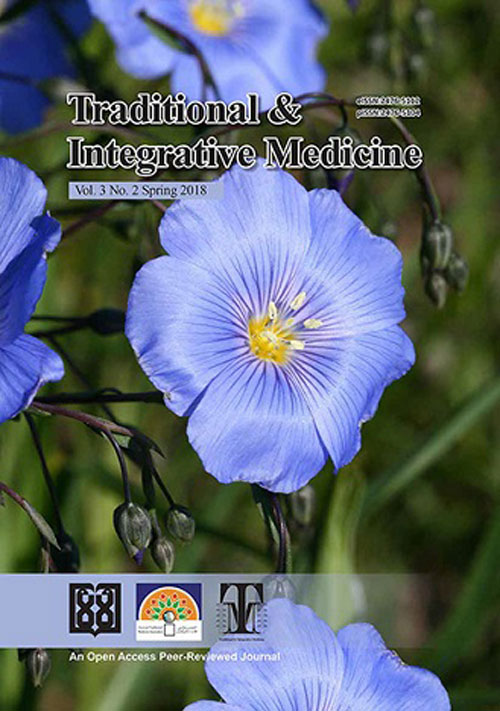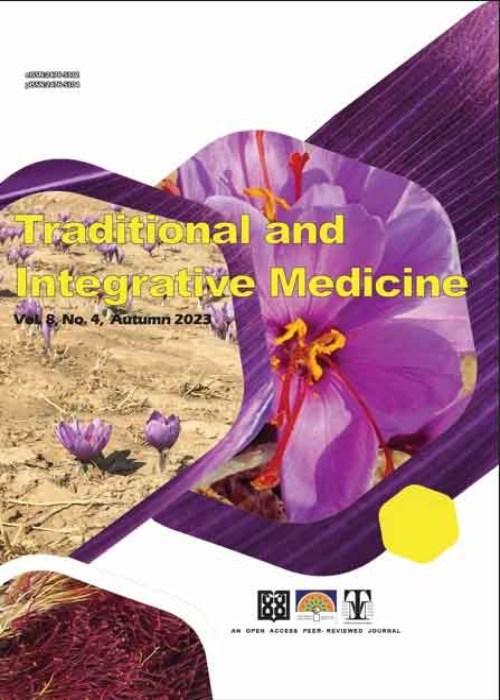فهرست مطالب

Traditional and Integrative Medicine
Volume:3 Issue: 2, Spring 2018
- تاریخ انتشار: 1397/03/30
- تعداد عناوین: 7
-
Pages 51-62The intensive heat treatment of roasting, a cooking method using hot air, has a major role in food industries. In Traditional Pharmacy of Iran, roasting was a common treatment for natural products. Therein, specific parts of medicinal plants and some minerals were necessarily roasted in order to obtain special characteristics. Qarabadin Salehi was searched to extract multi-component products which included roast ingredients. Effects and indications of each multi-ingredient, used part of ingredients, their proportion in formulation, and the percentage of roast part were mentioned. Thirty formulations which had at least one roast herbal or mineral component were found. They had been suggested for diarrhea, dysentery (Zahir), emesis, enteritis (Sahj), enteric ulcers, gastritis, gripe (maghs), hemorrhoid, and rectal hemorrhage. Other effects were carminative, digestive, liver tonic, stomachic, and tonic. Thirty cases of roast seeds, and ten cases of roast fruits were reported. Twenty-five compounds out of 30 improve abnormal fluid secretion into the small bowl and electrolyte imbalance symptoms. The formulations can be more effective in the case of liquid absorption. Generally, roasting has been a valuable treatment for processing natural products which are used in compounds for gastrointestinal disorders.Keywords: Roasting, Traditional Persian Pharmacy, Gastrointestinal, Diarrhea
-
Pages 63-68Bone defects have caused many problems. Restoration of bone defects with great gaps, has been a huge problem for many patients. Nowadays, different ways are used for bone restorations that cause difficulties; so there is tendency to use organic drugs such as propolis. The aim of this study was investigating the effects of nono-honey on calvarial defect. In this research 20 Wistar male rats were divided into two control and nano-honey groups. After general anesthesia, to access the calvaria, the midline was cut. We turned the skin and periosteum over and dig a fossa in parietal bone with electronic handpiece with 1000 round per minute (depth 5 mm and length 6 mm). After 8 weeks, histopathologic samples were provided and the new vessels, neutrophils, lymphocytes, macrophage, fibroblast, granulation tissue and formation of fresh bone trabeculae were measured. We observed that average number of neutrophils in nano-honey group was lower than control group, expressively (p = 0.030). The average of bone trabuculation in nano-honey group was more than other group (p 0.05). In this study, it was shown nano-honey has positive effects on restoration of hard and soft tissues. Since this research was carried out on rats more study and examinations on human beings are needed. Furthermore, adding osteoconductive and stimulant of regenerating bones in order to evaluate the effects on restoration is recommended.Keywords: Nano, honey, Reconstruction, Calvarial defect, Rat
-
Pages 69-77Hospital acquired pneumonia (HAP) caused by resistant microorganisms is one of the common reasons of mortality in hospitalized patients, which causes many complications and costs. In addition, nutritional support of a patient with pneumonia is very important. In this article, we present a case of pneumonia in which the therapeutic and nutritional instructions of Persian Medicine (PM) saved a patients life. The patient suffered from multiple trauma, affected by HAP during hospitalization. He was treated with a variety of broad-spectrum antibiotics for 9 days, but no improvement in the fever and respiratory state was observed, and eventually he was intubated and transferred to the ICU. Due to lack of improvement, he was treated with PM. One day after starting the treatment with PM, fever was reduced and was discontinued the following day. Three days later, the respiratory state improved and the chest X-ray was normal. Eventually, after 6 days the patient was discharged from the ICU.
Before starting the PM orders, despite the administration of multiple antibiotics, due to the lack of proper diet, there was no satisfactory response to treatment. The therapeutic approach of PM began with diet modification and improvement of the patient's digestive system and simultaneously benefited from herbal medicines to improve the patient's pulmonary status. The therapeutic methods of PM with special attention to temperament and the individual type of treatment and nutrition can be useful in many cases where conventional therapies do not improve the complications of the disease.Keywords: Hospital acquired pneumonia (HAP), Conventional medicine, Persian medicine, treatment -
Pages 78-83Traditional medicine has a long history of use in health maintenance and in disease prevention and treatment in different countries. Persian medicine (PM) is an old system rich in information about medicinal plants. Persian scientists have explained their beliefs about world phenomena by theory of quadruple temperaments as hot, cold, dry and moist. Makhzan al-Adviyah is one of the main PM herbal pharmacopeias. In this study, the useful medicinal plants for kidney, their temperament and suggested application were extracted from Makhzan al-Adviyah. Results obtained from this research showed that 66 plants with exact scientific name were mentioned in this pharmacopeia for kidney diseases. 65% of these plants have hot and dry temperaments which may be useful for restoring misbalanced temperaments of kidney diseases. From these plants, Pistacia lentiscus L. and Origanum vulgare L. showed beneficial effects to improve kidney disease through cellular and animal studies. Considering the long history and effectiveness of PM in the treatment of diseases, medicinal plants that presented in this study have important value for more research especially well designed clinical trials.Keywords: Kidney, Medicinal plants, Persian medicine, Temperament
-
Pages 84-90Epilepsy is a relatively common neurological disease classified as a chronic disease in modern medicine. Different treatments have been suggested for this disease, but they have failed in complete treatment of some types of epilepsy. Since Traditional Persian Medicine is one of the medical schools with special perspectives on epilepsy, we aimed to review the etiology and symptoms of epilepsy from the perspective of Dr. Ahmadieh, the contemporary physician, and some well-known traditional medicine practitioners [hakims] in order to obtain a new pattern in recognition and classification of epilepsy. Valid texts of traditional medicine in different historical periods including: The Canon of Medicine (Avicenna, 980-1037AD), Sharhe Asbab va Alamat (Nafis ibn Avaz Kermani), Zakhireye Kharazmshahi (Jorjani), Exire Aazam (Nazem Jahan), Moalejate Aghili (Aghili Alavai Khorasani Shirazi), Kholasat al-Hekma (Aghili Alavai Khorasani Shirazi), Tebe Akbari (Shah Arzani Dehlavi) and Mizan Al-Teb (Hakim Arzani) with focus on opinions of Dr. Ahmadieh (Abdollah Ahmadieh), were investigated. Relevant issues to epilepsy and its etiology and symptoms were reviewed and the common points and differences of various perspectives were gathered. According to traditional practitioners, epilepsy is a partial obstruction occurred in brain paths and ventricles preventing organs to perform their natural function. Familiarity with perspectives of traditional medicine from etiology and symptoms of epilepsy would help to suggest a new and practical classification of the disease. Thus, it seems that attention to these perspectives could provide a new approach for prevention, diagnosis and treatment of epilepsy.Keywords: Traditional Persian Medicine, Epilepsy, Preventive Medicine
-
Pages 91-105Catarrh is a common problem everyone experiences many times in his lifetime. According to Traditional Persian Medicine (TPM), Catarrh is related to the terms:Zokam and Nazleh. Zokam is defined as drainage of secretions through the nasal passage and Nazleh is defined as flow of them into the posterior nasal space and the oropharynx; Nazleh flows can also spread to the lungs, esophagus, stomach and some other organs and cause various complaints. Medieval Iranian physicians had paid special attention to appropriate treatment of Nazleh because they believed it is the source for many chronic diseases. According to the organ affected by Nazleh various diseases was expected from head to toe. Despite the great advances in medical treatments in recent years, effective drugs are still needed to control the clinical manifestations of catarrh. Drug resistance and the complications of the drugs make this requirement more apparent. Some of the herbs that were prescribed by former physicians have indicated concomitant therapeutic effects in recent researches so it seems that some components of the herbs can be beneficial in producing new drugs. It is hoped that a review on therapeutic methods of TPM will prompt further clinical benefits.
In this study, we reviewed several valuable TPM text books and collected the master viewpoints about etiology, semiology and treatment of Catarrh (Zokam and Nazleh), then we searched through some scientific databases including PubMed and Google Scholar to match the findings with the new research. The aim was to express the importance of these complaints and suggest convenient methods to treat them; considering that preventing and treating of some chronic diseases may relate to proper approach to Nazleh.Keywords: Catarrh, Postnasal drip, PND, Iranian traditional medicine, Zokam, Nazleh


